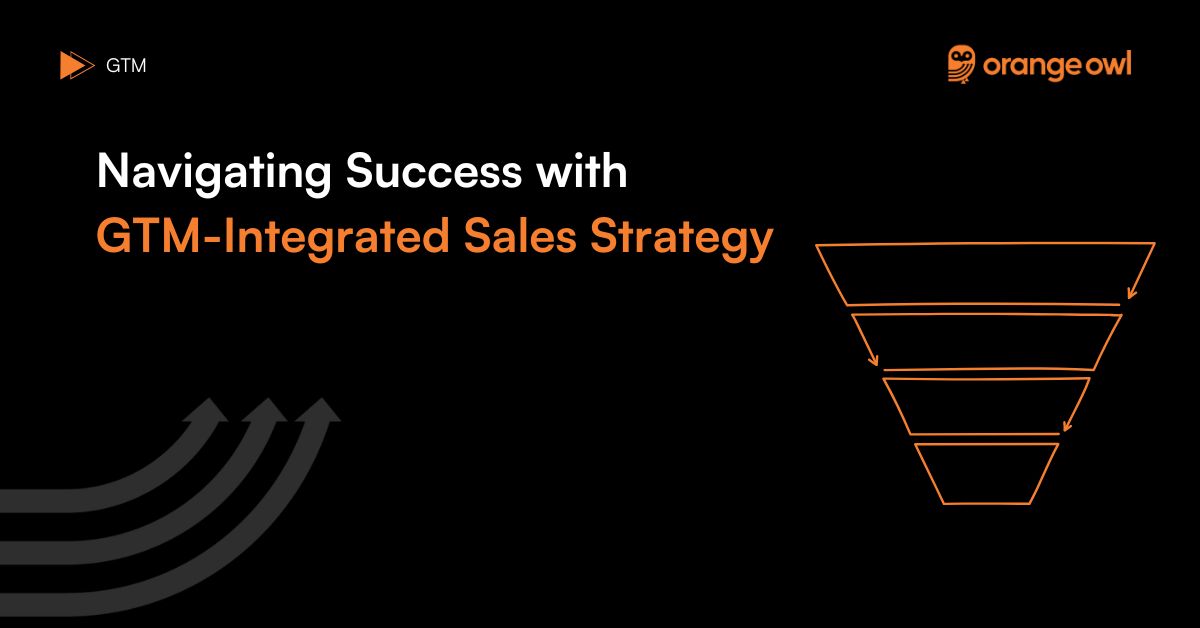Navigating Success with GTM-Integrated Sales Strategy
Vivek Goel
February 4, 2025

Table of Contents
In the competitive landscape of B2B industries, crafting an effective sales strategy is crucial for converting prospects into loyal customers and driving growth. Your sales strategy is a core component of your Go-To-Market (GTM) strategy, shaping how you engage with your target audience, address their needs, and ultimately close deals. This blog explores key elements of a successful sales strategy, using a B2B SaaS-based project management tool as an illustrative example.
GTM-Integrated Sales Strategy

1. Understanding Your Buyer’s Journey
To build a robust sales strategy, start by understanding your buyer’s journey. This involves mapping out the stages your target audience goes through from awareness to decision-making:
- Awareness: Prospects become aware of a problem or need.
- Consideration: Prospects research and evaluate potential solutions.
- Decision: Prospects decide on a solution and choose a vendor.
By identifying the key touchpoints and pain points at each stage, you can tailor your sales approach to meet the specific needs of your audience. For example, during the awareness stage, your goal might be to provide educational content that highlights common project management challenges. As prospects move to the consideration stage, you can offer detailed case studies and product demonstrations to showcase how your tool addresses these challenges.
Expert Tip: Use buyer personas to represent different segments of your target audience. This helps in tailoring your messaging and sales tactics to resonate with each specific group.
2. Building a Strong Sales Team
Your sales team is the driving force behind revenue generation. To ensure their success, it’s essential to equip them with the right tools, training, and support:
- Recruiting and Onboarding: Hire individuals with the right mix of skills and experience. Provide comprehensive onboarding to familiarize them with your product, market, and sales processes.
- Training and Development: Offer ongoing training to enhance their sales techniques, product knowledge, and understanding of customer needs. This can include workshops, role-playing exercises, and regular coaching sessions. Equip your sales team with battle cards, case studies, and demo scripts. Regular training sessions and feedback loops are essential for continuous improvement.
- Tools and Resources: Equip your team with advanced tools like Customer Relationship Management (CRM) systems to manage leads, track interactions, and analyze sales data. Sales enablement platforms can provide access to sales collateral, training materials, and other resources.
Scenario: Imagine a B2B company launching a new software product. They invest in an intensive onboarding program for their sales team, which includes detailed product training, market analysis sessions, and role-playing exercises to simulate customer interactions. This comprehensive training ensures that the sales team is well-prepared to handle complex customer inquiries and deliver compelling sales pitches.
3. Utilizing Technology
Leveraging technology is key to streamlining your sales processes and enhancing productivity:
- CRM Systems: Implement CRM systems to manage customer data, track sales activities, and automate follow-ups. This helps in maintaining organized records and providing personalized interactions.
- Sales Automation Tools: Use automation tools to handle repetitive tasks such as email outreach, lead scoring, and scheduling. This allows your sales team to focus on high-value activities like building relationships and closing deals.
- Data Analytics: Utilize data analytics to gain insights into customer behavior, sales performance, and market trends. This data-driven approach enables you to make informed decisions and optimize your sales strategy.
Innovative Tip: Integrate your CRM with marketing automation platforms to ensure seamless alignment between your sales and marketing efforts. This helps in nurturing leads more effectively and providing a unified customer experience.
4. Personalization and Relationship Building
In the digital age, personalized interactions and relationship-building are more important than ever:
- Tailored Approaches: Customize your sales pitch to address the specific needs and pain points of each prospect. This can involve personalized emails, targeted content, and bespoke product demonstrations.
- Nurturing Relationships: Focus on building long-term relationships with prospects and customers. Regular follow-ups, check-ins, and providing valuable insights can help in nurturing these relationships.
- Customer-Centric Mindset: Adopt a customer-centric mindset where the primary focus is on solving the customer’s problems and adding value to their business.
Scenario: A sales representative for a B2B technology firm takes the time to understand a potential client’s unique challenges. By providing a tailored demonstration of how their software can solve these specific issues, the representative builds trust and establishes a strong foundation for a long-term relationship. This personalized approach not only increases the chances of closing the deal but also fosters customer loyalty.
5. Continuous Improvement and Feedback
A successful sales strategy is not static; it evolves based on feedback and performance metrics:
- Performance Metrics: Track key performance indicators (KPIs) such as conversion rates, customer acquisition costs, and sales cycle length. These metrics provide insights into the effectiveness of your sales strategy.
- Customer Feedback: Regularly gather feedback from customers to understand their experiences and identify areas for improvement. This can be done through surveys, interviews, and direct interactions.
- Iterative Approach: Use the insights gained from performance metrics and customer feedback to refine your sales strategy continuously. This iterative approach ensures that your strategy remains relevant and effective in a dynamic market.
Expert Insight: Implement a closed-loop feedback system where insights from post-sale interactions are used to inform and improve pre-sale activities. This helps in creating a more cohesive and effective sales process.
6. Developing a Value Proposition
An essential part of your sales strategy is a clear and compelling value proposition. This is a concise statement that explains why a customer should choose your product or service over competitors. It should highlight the unique benefits and value your product offers.
- Identify Unique Selling Points (USPs): Determine what sets your product apart from the competition. This could be superior features, better customer support, cost advantages, or a more intuitive user experience.
- Communicate Benefits, Not Features: Focus on how your product solves problems or improves outcomes for the customer, rather than just listing its features.
- Validate with Social Proof: Use testimonials, case studies, and reviews to demonstrate the real-world impact of your product.
Scenario: A B2B cybersecurity firm crafts a value proposition that emphasizes their software’s advanced threat detection capabilities, ease of integration with existing IT infrastructure, and round-the-clock customer support. They back up these claims with testimonials from industry leaders and case studies showcasing successful implementations.
7. Tailoring Your Approach to Different Buyer Personas
Different segments of your target market may require different sales approaches. Develop distinct strategies for each buyer persona you identify:
- Decision Makers: High-level executives who are focused on ROI and strategic alignment. Tailor your approach to highlight the financial benefits and long-term value of your product.
- End Users: Individuals who will use your product daily. Focus on ease of use, time-saving features, and direct benefits to their workflow.
- Technical Influencers: IT or technical staff who evaluate the product’s compatibility and integration with existing systems. Provide detailed technical specifications and integration capabilities.
Innovative Tip: Create customized sales decks and demo scripts for each persona to address their specific needs and concerns effectively.
8. Implementing an Effective Follow-Up Strategy
Follow-ups are crucial in the sales process, ensuring that prospects don’t lose interest and move through the sales funnel:
- Timely Responses: Respond to inquiries and follow-up actions promptly. A quick response can significantly increase the chances of closing a deal.
- Personalized Follow-Ups: Use information gathered during initial interactions to personalize follow-up messages. Mention specific pain points or interests discussed previously.
- Automated Reminders: Use your CRM system to set automated reminders for follow-up actions, ensuring no opportunity slips through the cracks.
Scenario: A software company uses its CRM to automate follow-up emails after product demos. These emails are personalized with details discussed during the demo and include links to additional resources tailored to the prospect’s interests. This approach keeps the prospect engaged and increases the likelihood of a successful sale.
9. Aligning Sales and Marketing Efforts
A successful sales strategy requires close alignment with your marketing efforts:
- Shared Goals and Metrics: Establish common goals and metrics for both sales and marketing teams to ensure alignment and collaboration.
- Integrated Campaigns: Coordinate marketing campaigns with sales activities. For example, a lead nurturing email campaign can complement direct outreach efforts by the sales team.
- Regular Communication: Hold regular meetings between sales and marketing teams to discuss strategies, share insights, and adjust tactics based on performance data.
Expert Insight: Implement a service level agreement (SLA) between sales and marketing teams, outlining expectations, responsibilities, and shared goals to foster a collaborative environment.
Conclusion
Crafting a winning sales strategy is key to driving growth and success in your B2B endeavors. By understanding your buyer’s journey, building a strong sales team, leveraging technology, personalizing interactions, and continuously improving based on feedback, you can navigate the path to success more effectively within the framework of your Go-To-Market (GTM) strategy.
Frequently Asked Questions (FAQs) about Sales Strategy with GTM
Start by identifying the key stages your audience goes through:
- Awareness
- Consideration
- Decision-making.
Then, pinpoint the touchpoints and pain points at each stage to tailor your sales approach accordingly.
A strong sales team should have the right mix of skills and experience, comprehensive onboarding and training programs, and access to advanced tools like CRM systems and sales enablement platforms.
Popular CRM systems for B2B sales include Salesforce, HubSpot, and Zoho CRM. For sales automation, tools like Outreach, SalesLoft, and HubSpot Sales Hub are widely used.
Use buyer personas to understand the unique needs of different segments of your target audience, then tailor your messaging and sales tactics to address those specific needs and pain points.
Key performance metrics include
- conversion rates
- customer acquisition costs
- sales cycle length
- customer feedback and satisfaction
- channel performance metrics.
Create customized sales decks and demo scripts, address the specific pain points and interests of each segment, and use targeted messaging and content.
Respond promptly to inquiries, personalize follow-up messages based on previous interactions, set up automated reminders, and ensure regular communication with prospects.
Establish shared goals and metrics, coordinate campaigns between sales and marketing teams, and hold regular meetings to discuss strategies and insights.


